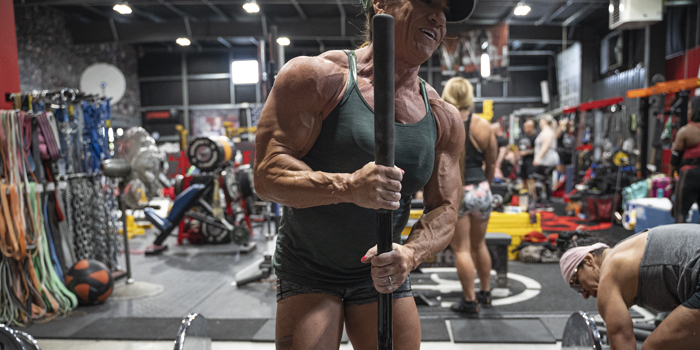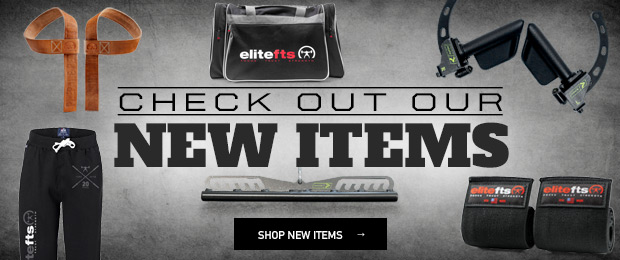
I see you on social media using a forward-walking version of a dumbbell Romanian deadlifts (RDL) as a rehab-type movement or for metabolic training purposes (in supersets or giant sets, for example). While it holds value, I don't think it's the best application for MOST people, gen pop, bodybuilding, or powerlifting.
While well-intentioned and natural, I see people struggle with movement moving backward. Most of our life is spent moving forward to some degree, so we're highly attuned to the world in front of us. Moreover, many of the same muscle groups responsible for stabilizing us under load become overactive or more "primary" and drive us to a more forward-oriented center of gravity. Just because you're bending forward and look like you're hinging doesn't' mean you're loading posteriorly.
Anti-Tin Man RDL
I've written about the Anti-Tin Man RDL.
before as a way to improve hip rotation and overall open up rotational mobility (which will do good things for your whole body). In this version, the wall allows proprioceptive stability from the heel on the wall.
One way to progress the Anti-Tin Man RDL is by taking that same pattern into a more dynamic and less stable environment through Walking RDLs. The walking version provides a dynamic progression incorporating improved spatial awareness and integration.
For Some Background
I'm using this with my husband Dave because his training through prep has, over time, drilled in already dialed in patterns that many of us fall into as our training blocks progress in intensity:
- "Locked in" and unable to rotate.
- Overactive in major stabilizing groups, losing the ability to "calibrate" and coordinate across multiple planes and muscle groups/chains. Rather than a balance, there's an over-dominance in certain patterns.
This is a natural phenomenon as training gets heavier. Therefore, we must lock into major groups to help us stabilize. However, as intensity increases, it's common to "dial-up" our already strong patterns, making it really tough to maintain appropriate coactivation and joint positions.
Especially deep in a bodybuilding prep where systemic fatigue is high from weeks of dieting, cardio, and trying to maintain intensity, it's common to slowly change your execution without fully realizing it. One of the hallmark qualities of training fatigue is difficulty coordinating smaller muscle groups across joints, leading to a change in stabilization patterns.
Over time, Dave gradually broadened his stance on his main overload movement for his lower body sessions. For him, a wider stance gave a greater perception of stability, power, and strength. It worked with his hip structure and strongest muscle groups (lower back, adductors, quads) when fatigue was high.
Over a series of weeks, however, the change in setup and execution caused enough shift in relative position of the hip joint (via widening out his stance and modifying pelvis position) that he ended up with an injury that he needed to work through.
He's modified his main heavy pulling movement to a barbell RDL, which still maintains (for him) a relatively forward orientation via manipulation of the pelvic inlet and outlet position due to the sheer amount of weight he uses.
As he approaches his peak week, I've given him some correctives to do at home, as well as some low-load, high-return movements to use this week to improve patterns. These will allow him to train hard, heavy, and maximize his rebound period working with Justin Harris.
In the second video, I'd change more than a few things about his execution. As you can see, he shifts right very naturally. When he tries to shift left, he's not really fully loaded into his left hip, yet he's still "braced" on his right side. He could kick his left hip out to the side a little more.
It's important to note that when coaching exercises like this, as much as 'perfect' execution would be ideal, I tend to find that "good enough" and building a foundation is the most important thing.
It's incredibly easy to overcue an athlete and with someone like Dave (who is more concerned about, "Am I doing it right?" than, "What should I feel?"), the last thing I want to do is leave him feeling unable to perform what he needs to.
As he improves his execution, I'll get pickier with him in the next few days. Rather than trying to major in the nuances, I want to ensure I get the big rocks in place, put the pebbles in the cup, and finally, fill with sand as needed.
Most times, when I'm working with an iron sport athlete, I tend to find that the big rocks cover the bases. If we want to get granular, they almost always benefit, but often, I'll get more granular on execution in their training. This is where coaching becomes a bit of an art—knowing when to get granular versus when to start building the foundation. Right now, I'm just building the foundation with him.
Walking RDL
Similar to Cross-Body Cable Extensions, you can make Walking Romanian RDLs as simple or as complex as you want. Regardless, be sure to:
- Shift back—exactly why I MUCH prefer a backward walk rather than a forward walk
- Laterally shift the zipper line over your big toe
- Dissociate hip movement from a lower back movement
As Dave shifts back, his inferior glutes (pelvic outlet) should "open" in a way that allows him to extend FROM a glute rather than from his back.
The big key here is being able to actually shift into and fully utilize a posterior, inferior hip. Remember, just because you're hinging doesn't necessarily mean you're loading and utilizing full rotational capability of the hip. If you can't flex "INTO" the hip, you won't extend out of it. Instead, you'll extend from patterns where you already brace from.
For Dave, that meant extending "out" of hip pseudo-flexion by using his back, flaring his ribcage forward, and staying largely in the sagittal plane.
What I'd like him to do is be able to utilize his adductors to both:
- Stabilize the inferior/posterior portion pelvis underneath him, and
- Pull" him into his left side
Biggest Takeaways
Most of us need to work on allowing our weight to shift back. At one point in the video, Dave even states he feels like he's going to fall over. Rather than performing a forward-walking dumbbell RDL, try performing it "retro" style.
As you go through the motion, take it slow, and focus on where you're moving.
Where you move into is where you will likely move out of.
If you struggle loading the hip, you can regress this to the more stable, wall-supported version of the rotational Anti-Tin Man RDL.
Dani is a Doctor of Physical therapy, CSCS, nationally qualified women’s physique competitor, and elite level powerlifter in the 123 class. She's the first to admit she pushes the envelope with training, which Dani is a Doctor of Physical therapy, CSCS, nationally qualified women’s physique competitor, and elite level powerlifter in the 123 class. She's the first to admit she pushes the envelope with training, which uniquely allows her to blend principles of rehab with a love for all things iron. Creativity, relationships, and trust drive her to empower coaches and athletes with tools and education from a PT who understands training demands. Visit MERGE Performance to learn more (remote PT services, consults, and training).










